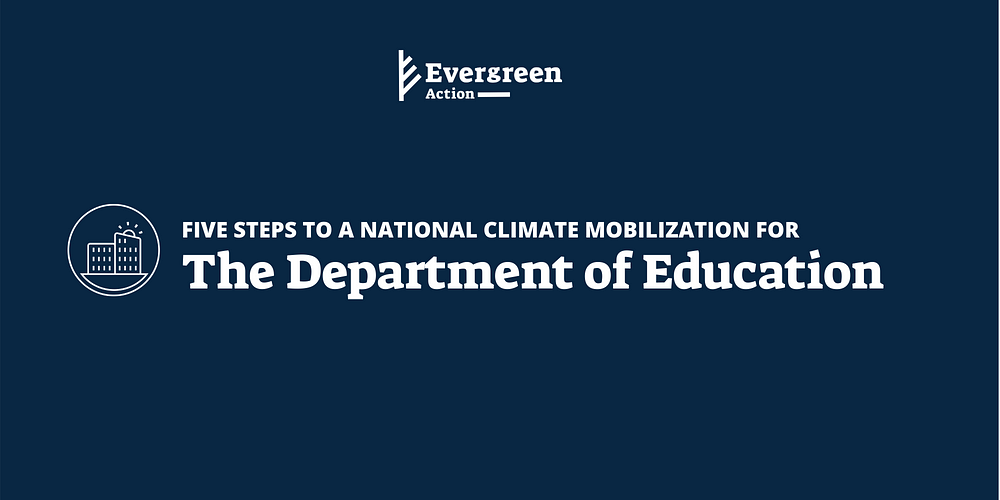5 Action Steps for the Department of Education to Lead a National Mobilization to Defeat the Climate Crisis

Trump Education Secretary Betsy DeVos leaves behind a legacy of damaging public education, deliberately worsening inequalities in America’s education system, and denying scientific reality. Now, America has the opportunity to switch from a Secretary of Education who denies climate change to a Secretary of Education who will lead the charge to defeat climate change. As Secretary of Education, Miguel Cardona can restore science to the U.S. Department of Education and lead the way on clean energy and equity in America’s schools.
>>Visit the Evergreen Action website to learn more about our work<<
The Department of Education has a critical role to play in the Biden Administration’s full-government mobilization to defeat climate change. Miguel Cardona should take action to electrify America’s school buses and retrofit 100,000 school buildings to make them carbon-free, energy efficient and climate resilient. Building upgrades are proven to improve public health and learning outcomes for students, and they will create countless jobs. The Department of Education can also strengthen the green economy by providing loan forgiveness for climate careers, issuing grants for K-12 environmental education, and prioritizing STEM education and green career training for minority and low-income populations. All of these investments should utilize equity mapping to align with Biden’s promise to deliver 40% of green investments for vulnerable communities.
The Department of Education’s responsibility is to invest in our children’s futures. As Education Secretary, Miguel Cardona must mobilize the resources at his disposal to create a thriving, just, clean energy future for everyone.
In order to realize Biden’s climate mandate, every federal agency must become a climate agency. The Department of Education will be critical in this effort. Today, Evergreen Action is releasing 5 concrete actions that the next Department of Education must deliver in the all-out government mobilization to defeat the climate crisis:
1. Invest in Carbon-Free and Healthy School Buildings
The Biden administration should set a goal to make 100,000 school buildings carbon-free and retrofit them for public health response, by the end of the President-elect’s first term. The next Secretary of the Department of Education can realize this goal by leveraging the Department’s existing resources for school building modernization. It should work in partnership with the Energy and Treasury Departments, as well as state and local governments, to invest in upgrading school buildings for energy efficiency, electrification, ventilation and healthy building improvements, renewable energy, and climate resilience. These school building retrofits should be conducted using minimum federal standards, including labor and job quality standards, and federally-backed bonds to finance projects, which will be repaid through energy savings. Investments should be prioritized in schools located in marginalized communities, as identified by the Environmental Protection Agency’s Equity Mapping tool.
2. Launch a Partnership with the Department of Transportation to Electrify Public School Buses
The Department of Education should spearhead a partnership with the Department of Transportation to develop a program using the agencies’ existing authority to finance electrification of school bus fleets in public schools across the country — starting with schools in rural areas and marginalized communities. Existing Department of Education grant programs for rural schools can be used for transportation and the DoT offers a range of grant programs, which can be used for school bus fleet procurement, new charging infrastructure, and other upgrades to improve student access and mobility.
3. Establish Loan Forgiveness Program for Climate Careers
The Higher Education Act of 1965 gave the Department of Education the legal authority to cancel or forgive student loans without additional congressional approval. Using this authority, the Department should launch a loan forgiveness program for students who pursue careers in clean energy, sustainability, climate science and environmental justice in the non-profit and public sectors, or who participate in a Climate Conservation Corps service program, with ongoing engagement in mentorship and career networks. This loan forgiveness program could be modeled after the existing Teacher Loan Forgiveness or Public Service Loan Forgiveness programs.
4. Issue Grants for K-12 Climate and Environmental Education, and Extracurricular Programs
The Department of Education should prioritize relevant funding resources, such as Institute of Education Sciences grants or the Investing in Innovation grant program, to support research and educational programs focused on environmental and climate science, sustainability, and environmental justice education at K-12 schools. Investments should be prioritized for in schools located in marginalized areas, as identified by the Environmental Protection Agency’s revamped Equity Mapping tool.
5. Fund STEM Education and Green Career Training for Minority and Low-Income Populations
In order to facilitate an equitable transition to a clean energy economy, the Department of Education should prioritize grant funding for STEM education and green career training at HBCUs and other Minority Serving Institutions and use programs like the Minority Science and Engineering Improvement Program to support the expansion of programs in STEM education, technical, and scientific career training focused on climate and clean energy. The Department of Education should also support vocational training and union apprenticeship programs for clean energy and climate resilience work. Participants in these educational programs who pursue qualifying green careers would also be eligible for the Department’s climate careers loan forgiveness program.
